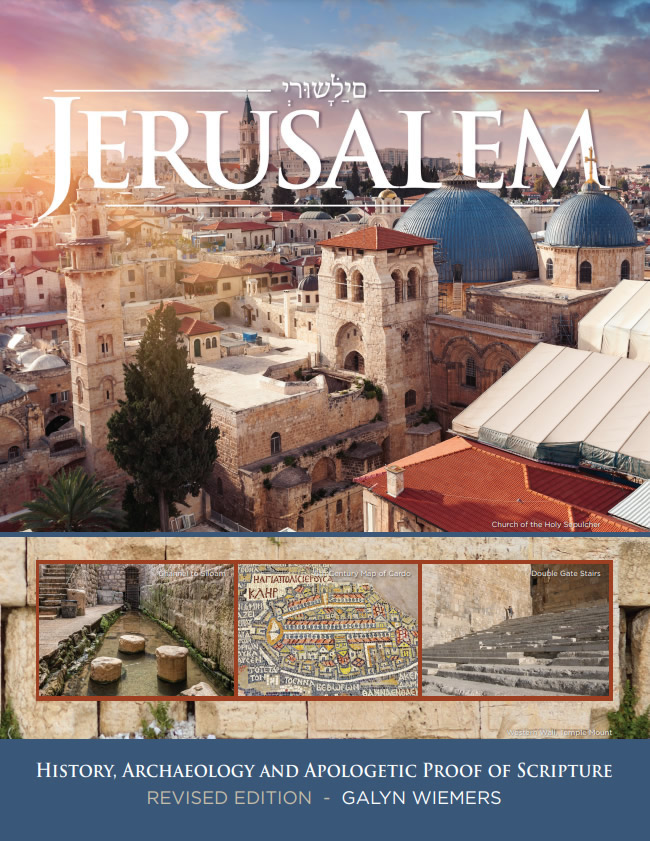 |
This Roman column was set in place around 200 AD near the camp of the Tenth Roman Legion, which had been stationed in Jerusalem since 70 AD. Today this pillar is located in the Christian Quarter at an intersection of four covered streets, which is up a narrow road going north, just inside the Jaffa Gate. The inscription reads:
Marco Iunio
Maximo
Legato Augustorum
Legionis X Fretensis
C. Domitius Sergius
Antoninianae
Strator eius
The inscription on the column recognizes Marcus Iunius Maximus who was the governor of the province of Judea and commander of the Tenth Roman Legion. Marcus Maximus is identified by two titles:
- He is “Legate of the Augusts” (Legato Augustorum). Being a legate means he held the office of general in the
Roman army and that he was from the senatorial class. In this case, he was also appointed as the Governor of Judea.
- He is also the general and commander of the Tenth Roman Legion known as “Legio X Fretensis,” or “Tenth
Legion of the Sea Strait”. This was the legion (about 4,500 men) organized by Augustus in 40 BC to fight during the Civil War against Marc Antony, who attempted to dissolve the Roman Republic. The symbol of the Tenth Legion of the Sea Strait was a bull, a ship, and the god Neptune. This Tenth Legion was stationed in Jerusalem for 200 years and is last recorded to exist around 410 AD. |
 |
The emperor, or “Augusts” referred to in the phrase “Legate of the Augusts” would have been Septimius Severus. The column and inscription were erected by C. Domitius Sergius Honoratus, (“C. Domitius Sergius Antoninianae” in the fifth and sixth lines), one of Marcus Maximus’ aids. Galyn points at LEGXFR in the fourth line which is “Legion 10 Fretensis” or the name of the Tenth Roman Legion Fretensis which means “Sea Strait”. |
 |
A Roman column stands in the Batei Mahase Square with the arches of the Rothschild House (built in 1871) in the background. Scratched on the drum of this Ionic capital is the Roman numeral 9, written “VIIII”. The number 9 is a reference number engraved by the designers of the column to indicate to the builders where this column should be positioned. The placement of the number on the drum indicates that this portion of the column was positioned at the top of a column that could have been 30 feet tall. This column might have been one of the top pieces of a column in the colonnade on the New Testament Temple Mount known as Solomon’s Colonnade. |
 |
Herodian Capital from a column from New Testament times. |
 |
|
 |
This is an Attic base of a Roman column next to the column above. The number 4 is inscribed on the second layer on the coved base as “D”, which is the Greek letter Delta. The number indicates that this column base was the fourth in a row of columns. It has not yet been determined which building these columns belonged to. |
 |
The Roman inscribed Delta which represents the number 4. This would have been the fourth column in a series of columns. |
 |
Column capital in Jerusalem from New Testament Temple Period.
Column capitals designed like these are identified with the royal construction of the First Temple period of the Old Testament. |
 |
Toni records a few of the many ancient cedar or cypress beams abandoned on the Temple Mount by the Eastern Gate (Golden Gate). Some of these beams have been dated back to both Herod’s Temple Mount construction, and one beam was dated to 950 BC the time Solomon’s first temple was constructed.
Hiram king of Tyre sent Solomon cedar logs from Lebanon for Solomon’s construction projects in Jerusalem that included the Temple and the Royal Palace. Solomon wrote to King Hiram in Tyre asking for cedar logs to build the Temple:
Solomon wrote to King Hiram in Tyre (in the land of ancient Phonecia, or modern Lebanon):
“Solomon sent this message to Hiram king of Tyre: ‘Send me cedar logs as you did for my father David when you sent him cedar to build a palace to live in. Now I am about to build a temple for the Name of the Lord my God and to dedicate it to him.’ ” – 2 Chronicles 2:3-4
Hiram wrote to Solomon:
“Now let my lord send his servants the wheat and barley and the olive oil and wine he promised, and we will cut all the logs from Lebanon that you need and will float them as rafts by sea down to Joppa. You can then take them up to Jerusalem.”
– 2 Chronicles 2:15-16
“So Solomon built the temple and completed it, roofing it with beams and cedar planks. And he built the side rooms all along the temple. The height of each was five cubits, and they were attached to the temple by beams of cedar.” – 1 Kings 6:9-10
The Temple and other building projects of Solomon stood until the Babylonian destruction of 586 BC. Even then the stone and much of the wood that did not burn remained in the rubble. Through the ages pieces of previous buildings and structures have been reused when the new construction took place on the Temple Mount. When the exiles returned in 539 BC from captivity and again when they finished the Temple Zerubbabel oversaw the previous stones, blocks and even wood not destroyed in fire were used to rebuild. Wooden beams made of the cedar from Lebanon and cypress were used in construction according to the Bible and other ancient documents not only during the time of David and Solomon, but also Ezra/Zerubbabel (539-520 BC) and Herod (19 BC-20 AD). Sometimes new cedar was ordered from Lebanon and delivered.
“Then they gave money to the masons and carpenters, and gave food and drink and olive oil to the people of Sidon and Tyre, so that they would bring cedar logs by sea from Lebanon to Joppa, as authorized by Cyrus king of Persia.” – Ezra 3:7
In 520 BC, even the Lord himself directed the people of Jerusalem to build the Temple with timber from the mountains of Lebanon:
“Go up into the mountains and bring down timber and build my house, so that I may take pleasure in it and be honored,” says the Lord.” – Haggai 1:8
Some of these beams from the ancient Temple Mount structures have been found in reuse in the Al Aqsa Mosque built on the south end of the Temple Mount 695-705 AD. After earthquakes in 746-749, 1033, 1927 and 1937 reconstruction occurred and some wooden beams were removed, reused or put into storage in those days. In the 1900’s many of these beams were studied and dated. Today some of these beams can still be seen in the ceiling of the Al Aqsa Mosque. The removed beams that were found to have ancient wood carvings for decoration are preserved in the Rockefeller Museum in Jerusalem. One of the timber was carbon dated to the time of Herod’s construction around 20 BC. Others were dated from 900-100 BC. One beam was dated to 950 BC during the time of Solomon’s temple. A large portion of the beams come from the Byzantine Period around 500 BC. |
 |
An ancient beam still remained by the Eastern Gate in 2010, but has since disappeared like the many others.
For years many of the beams that were not being reused were simply piled up on the Temple Mount exposed to the elements. Some were abandoned by the Eastern Gate, left unsecured and eventually over time were taken. These disappeared and were never analyzed.
One beam was found with Roman style carving from the time of Herod’s Temple construction. This beam also had impressions left in it from having sat on columns. The column impressions were at the 10.8 foot marks. That distance matches the interval that the columns of Solomon’s Colonnade that was built around Herod’s Temple Mount. This Colonnade is referred to in the New Testament.
“Jesus was in the temple courts walking in Solomon’s Colonnade.” – John 10:23
“While the man clung to Peter and John, all the people were astonished and ran to them in the walkway called Solomon's Colonnade.” – Acts 3:11
“The apostles performed many signs and wonders among the people, and with one accord the believers gathered together in Solomon's Colonnade.” – Acts 5:12
(Confirmation scientific analysis referred to above can be found in Peretz Reuven’s article “Wooden Beams from Herod’s Temple Mount: Do They Still Exist” in Biblical Archaeology May/June 2013, and at many online sources.) |
 |
This Roman column from the reign of Vespasian (69-79 AD) and his son Titus (79-81 AD), was found built into the foundation of a Umayyad building constructed by the Muslims around 661-700 AD. This pillar mentions Vespasian, Titus, Lucius Flavius Silva (commander of the Tenth Legion from 73-80 AD), and the Tenth Legion itself. Notice the fifth line has been chiseled off to remove Lucius’ name. This column was probably originally part of the Cardo columns and was likely set in place by the Romans around 79 AD. The inscription and its translation are below. |
 |
The translation is:
Imperator Caesar
Vespasianus
Augustus, Imperator Titus Cae-
sarVespasianus Augustus Filius
[Lucius Flavius Silva legatus]
Augusti pro praetore
Legio X Fretensis |
 |
The original Cardo pavement is preserved in this photo with the Roman game board cut into the lower left stone of the original street . |
 |
A Roman street game marked in the pavement of the Cardo in the Jewish Quarter. The square shapes cut inside of each other provided the playing spaces of a game used sometime after 135 AD.

|
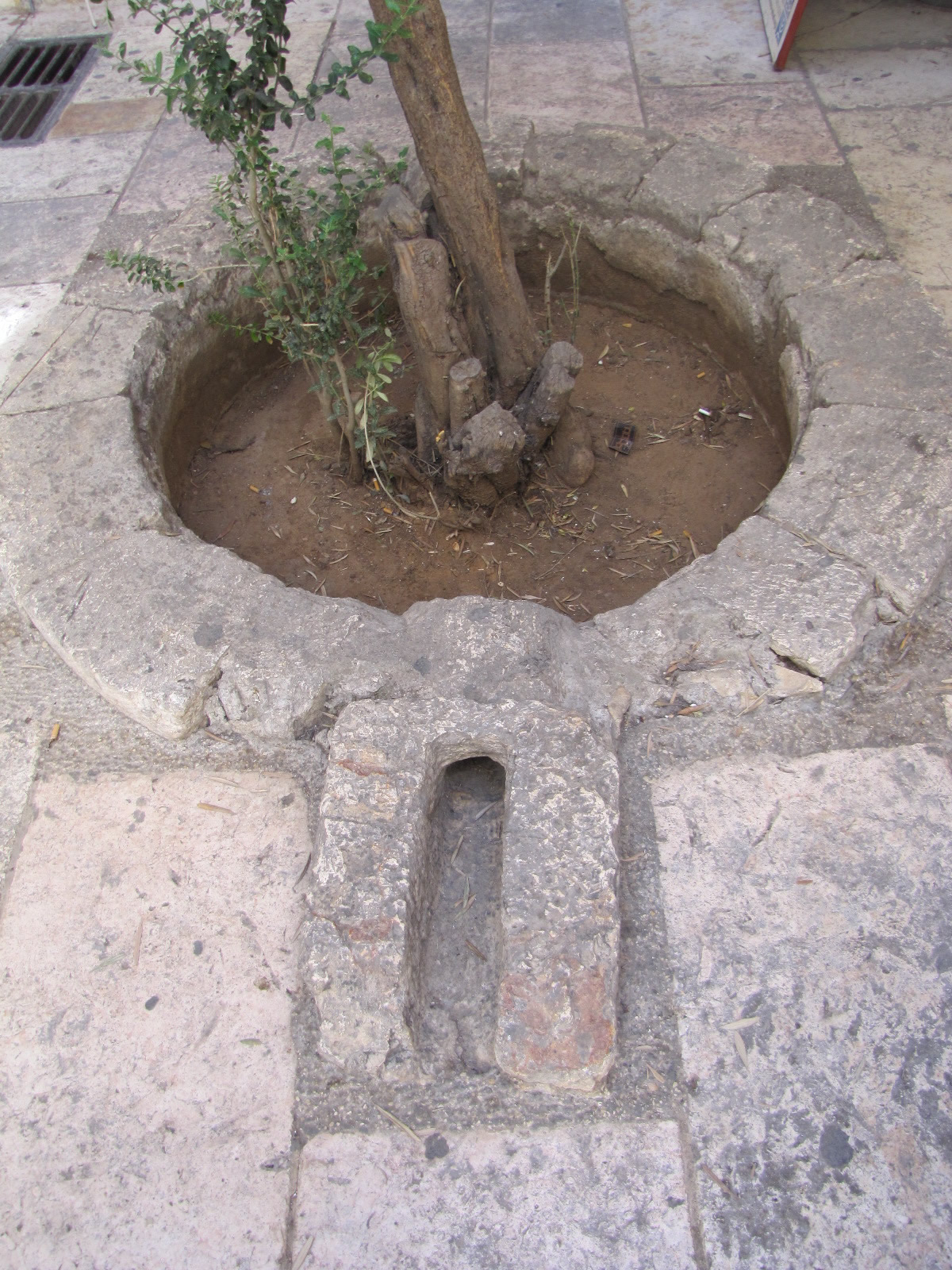 |
An ancient wine press, or possibly a well, that provided access to a cistern below, sets in the modern street of the Jewish Quarter as large planter for a tree. |
 |
Toni stands in a large community wine press above where people would crush the grapes with their feet. She is looking over the wall at the drain that carried the wine into the vat below. |
 |
Galyn stands barefoot in an ancient private wine press. The grapes would be placed in the carved out square depression in the bedrock where they would be walked on until the juice flowed into the deeper circular vat. |
 |
An ossuary that was used to store the bones of the deceased after the body had decayed. The body would be laid in a tomb for about a year. At the end of that time, family members would return to collect the bones and place them in an ossuary. The box of bones would then be placed in a tomb along with the bones of other deceased family members. The burial chamber, or burial slab, could be used over and over through many generations since each body only remained on the slab until it had decomposed. |
 |
Ossuaries were placed in the front of a tomb. This photo shows a tomb from around the time of Jesus. The tombs of Old Testament times were cut in a slightly different way, and sometimes included a hole or opening under the burial bench where the bones would be placed. As each person died their bones would be collected from the burial bench and laid in the compartment underneath, along with those of their ancestors. In other words, the dead person’s bones would be gathered and placed with the bones of their fathers.
After that whole generation had been gathered to their fathers, another generation grew up . . .
– Judges 2:10 |
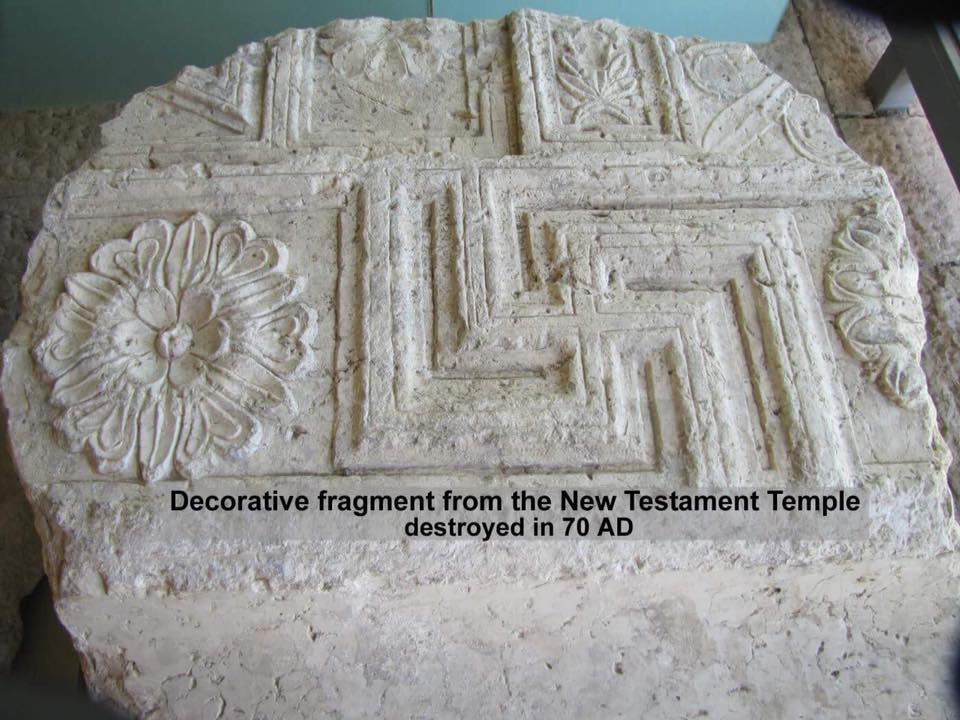 |
A decorative rock fragment from Herod’s Temple precinct found at the base of the Temple Mount where it fell in the Roman destruction of 70 AD. |
 |
Fragments from the New Testament Temple Mount. |
 |
A floral pattern carved into stone found in the destruction layer of the Temple Mount at the base of the west wall. |
 |
Stone craftsmanship in stone from the first century temple mount. |
 |
The olive press, stage one:
An olive press. The first step in making olive oil was to crush the olive and the seed. This was done in this crushing mill. The olives were placed in the base and the top round stone (wheel, disk or crusher) was rolled over the olives while it was pushed around and around by using a beam sticking out of the hole the top round stone (disk). One or two people would push the top stone around with the wooden beam until the olives and the seeds where crushed into a soupy olive mash. From here the soupy olive mash was moved to the second phase of the olive press. |
 |
An Olive Press |
 |
An Olive Press |
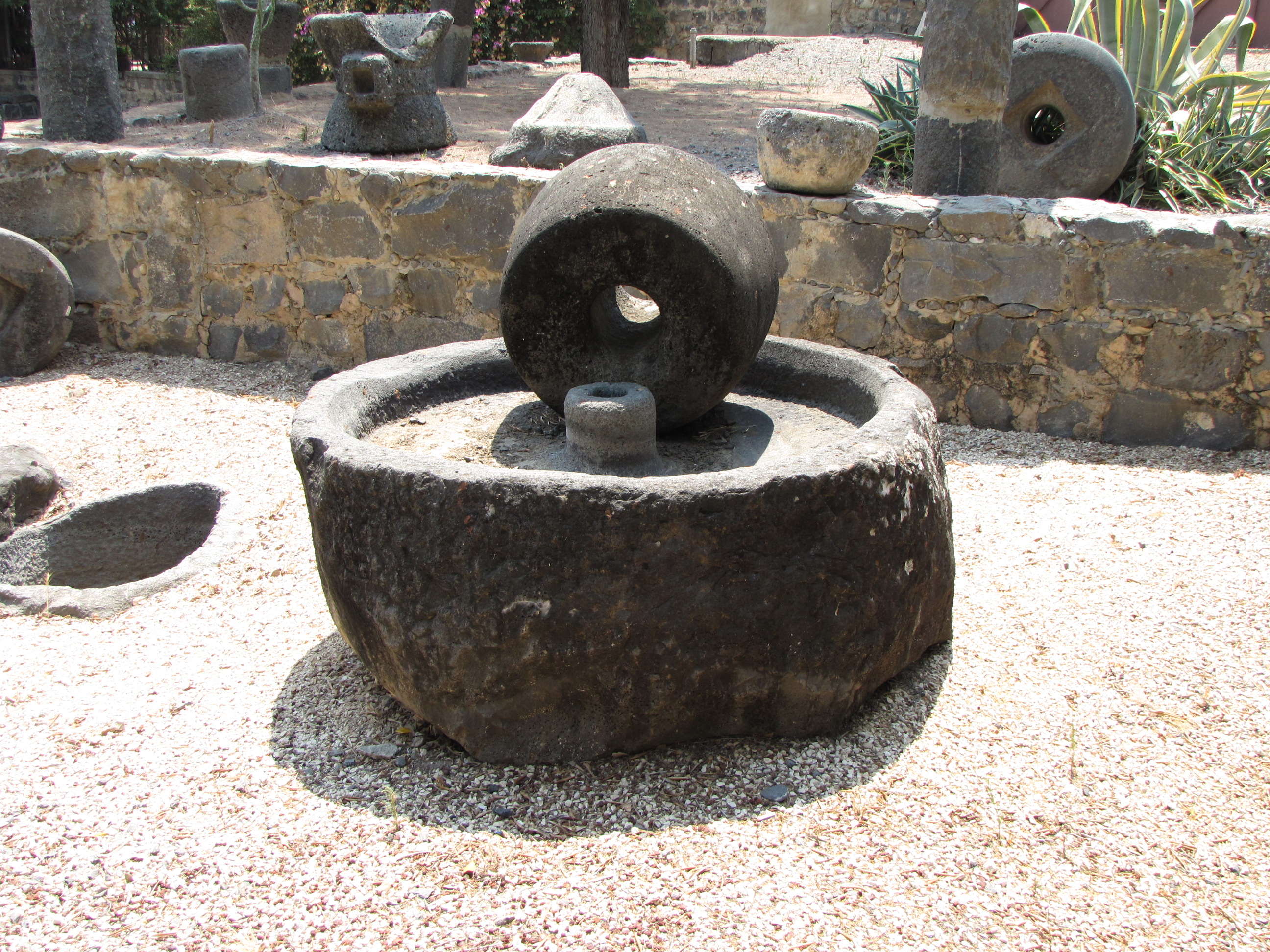 |
An Olive Press |
 |
The olive press, stage two:
The crushed, soupy olive mash was place on a flat stone encircled with a trench that captured the pressed olive oil leading it to flow into a pit or a container in the ground. Pressure was applied to the top of the olive mash by rotating a threaded screw device to force pressure or by applying leverage to a heavy stone. The result was olive oil being squeezed out of the soupy mash into the groove cut around the flat stone. Above is a photo of an oil press that would use threaded screw pressure to squeeze out the olive oil. |
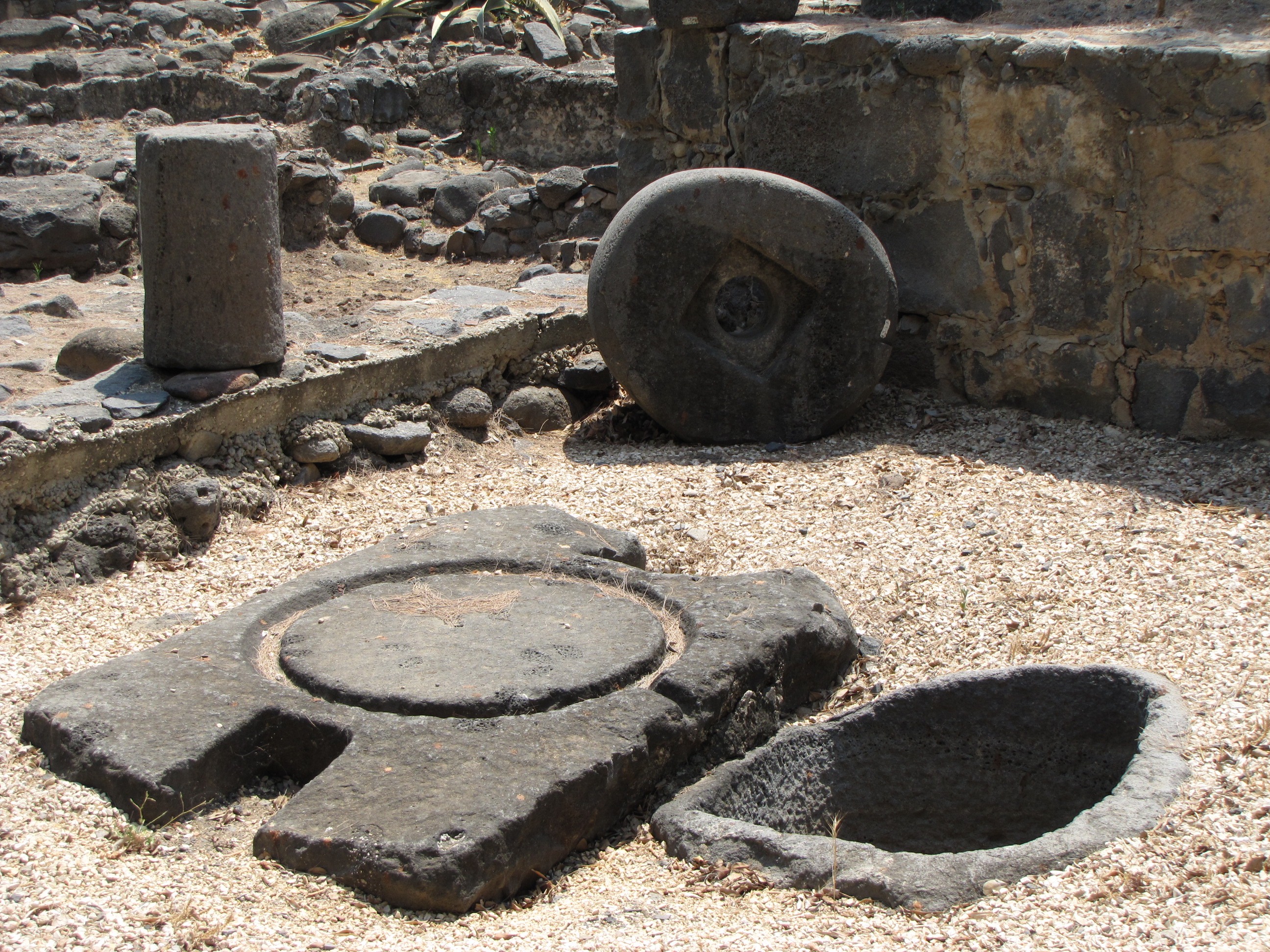 |
This is the flat stone base the soupy, olive mash would be placed on to crush the oil out. The oil would spill over into the circular trench around the flat stone and flow out the opening in the side into the pit in the ground where it would be collected. |
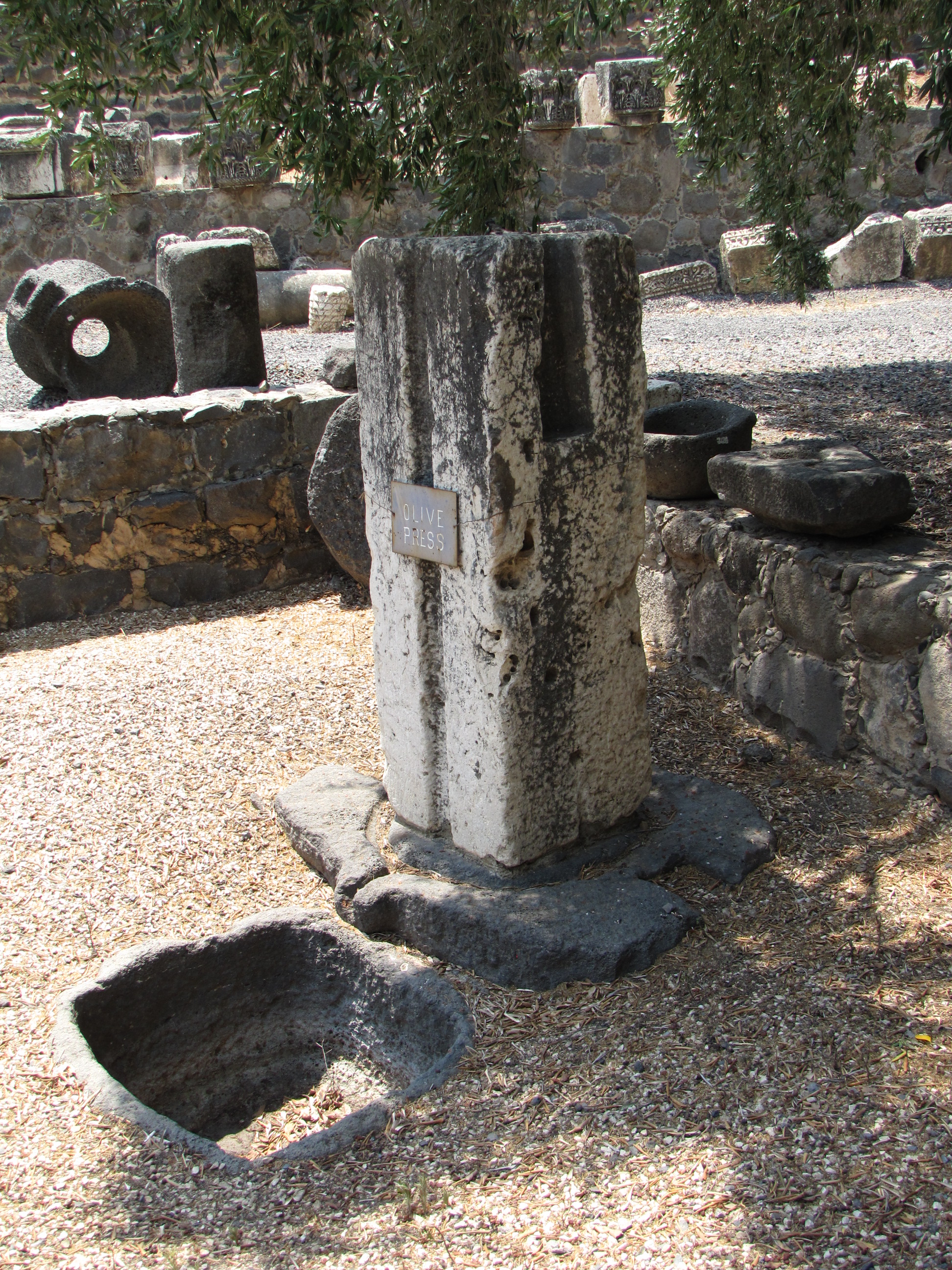 |
In this photo the pit and the flat stone with the circular trench can be seen. On top of the flat stone press is a large, heavy stone with notches to insert a beam to apply leverage to the already heavy stone pressing down on the olive mash. |
 |
The bottom cone-shaped stone of the mill is covered by the rotating stone set on the top. The grain is poured in from the top, slides down the sides of the triangular shaped cone and is crushed between the stones as the top stone rotates around the sides of the bottom stone. The crushed grain falls out the bottom. The ground grain is often caught in a groove or trench cut into the bottom stone. Wooden beams or handles would fit into the socket cut into the top stone. The wooden handle would be used to rotate the top stone as the grain was poured into the center shaft of the top stone onto the top of the cone shape of the bottom stone. |
 |
|
 |
An industrial size basalt stone mill. |
 |
Two pieces mill |
 |
Top and bottom mill stones |
 |
Bottom cone shaped mill stone |
 |
Bottom stone of the mill made out of basalt stone |
 |
|
 |
Handmill with two handles for one person to operate. Made of basalt stone. |
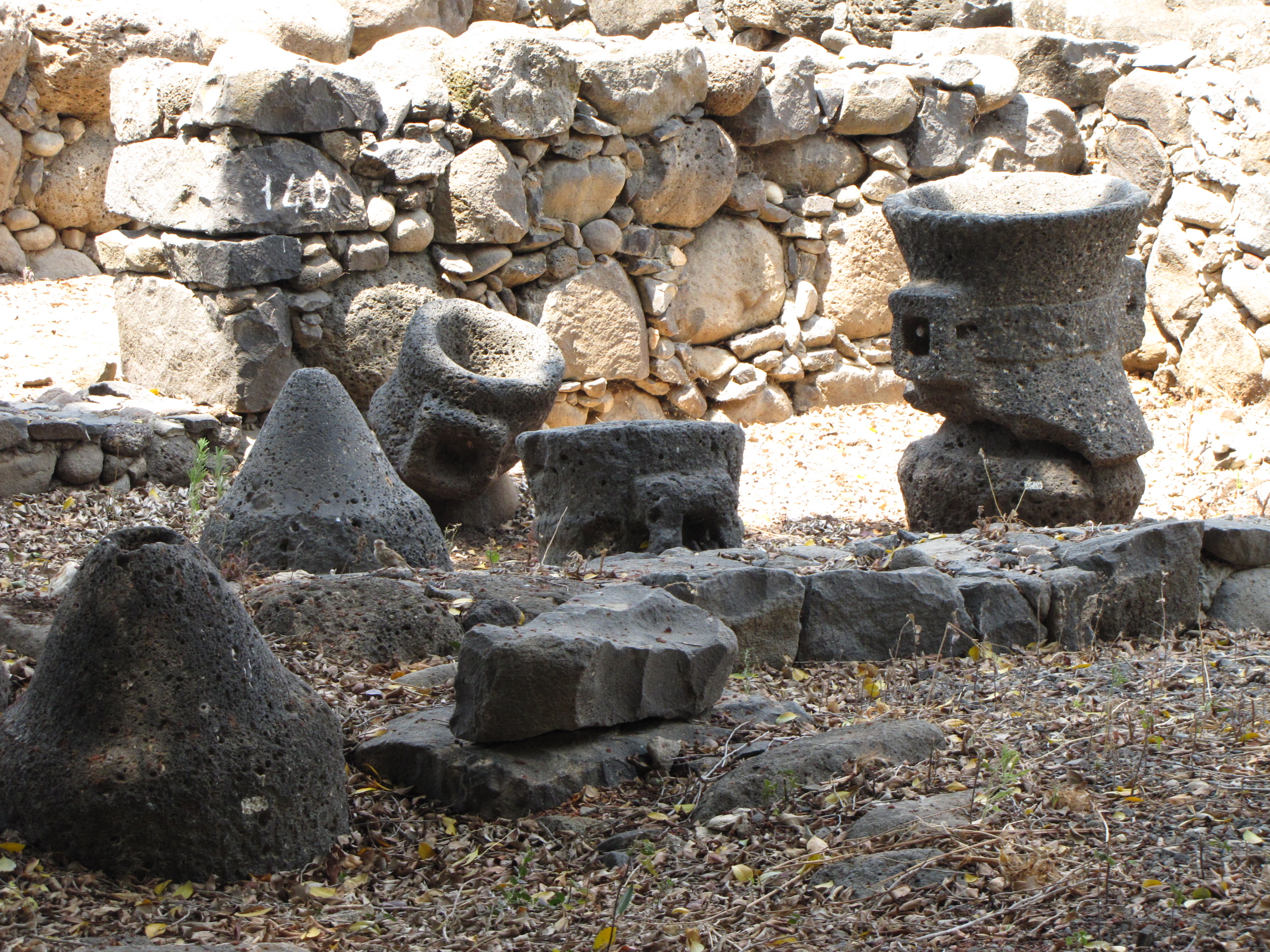 |
Pieces of several basalt stone mills |
 |
Basalt mill stone setting by a stone manger. The manger was a stone watering trough for animals. Mangers or watering troughs were cut from stone (like so many things were). If the manger was used to water sheep or goats, like the one setting by the mill stone, it would be 12-15 inches high. If it was use to water horses or donkeys the manger would be 24-30 inches tall. |
 |
These are taller and larger mangers used as watering troughs for horses. These were usually 24-30 inches tall. They were cut out of a single block of stone. |
 |
1900 BC Babylonian cuneiform clay tablet in Sumerian cuneiform text. This shows administrative details and has the title of the document on the side of the tablet identifying the details in the document. |
 |
1900 BC Babylonian cuneiform clay tablet with administrative information in Sumerian text. |
 |
1700-1500 BC cuneiform tablet with seven lines of Babylonian cuneiform text listing areas of land along with the names of six men and their professions that the land was granted to for their service to the king. |
 |
|
 |
Ancient demotic script on papyrus from 400’s BC until 200 AD. |
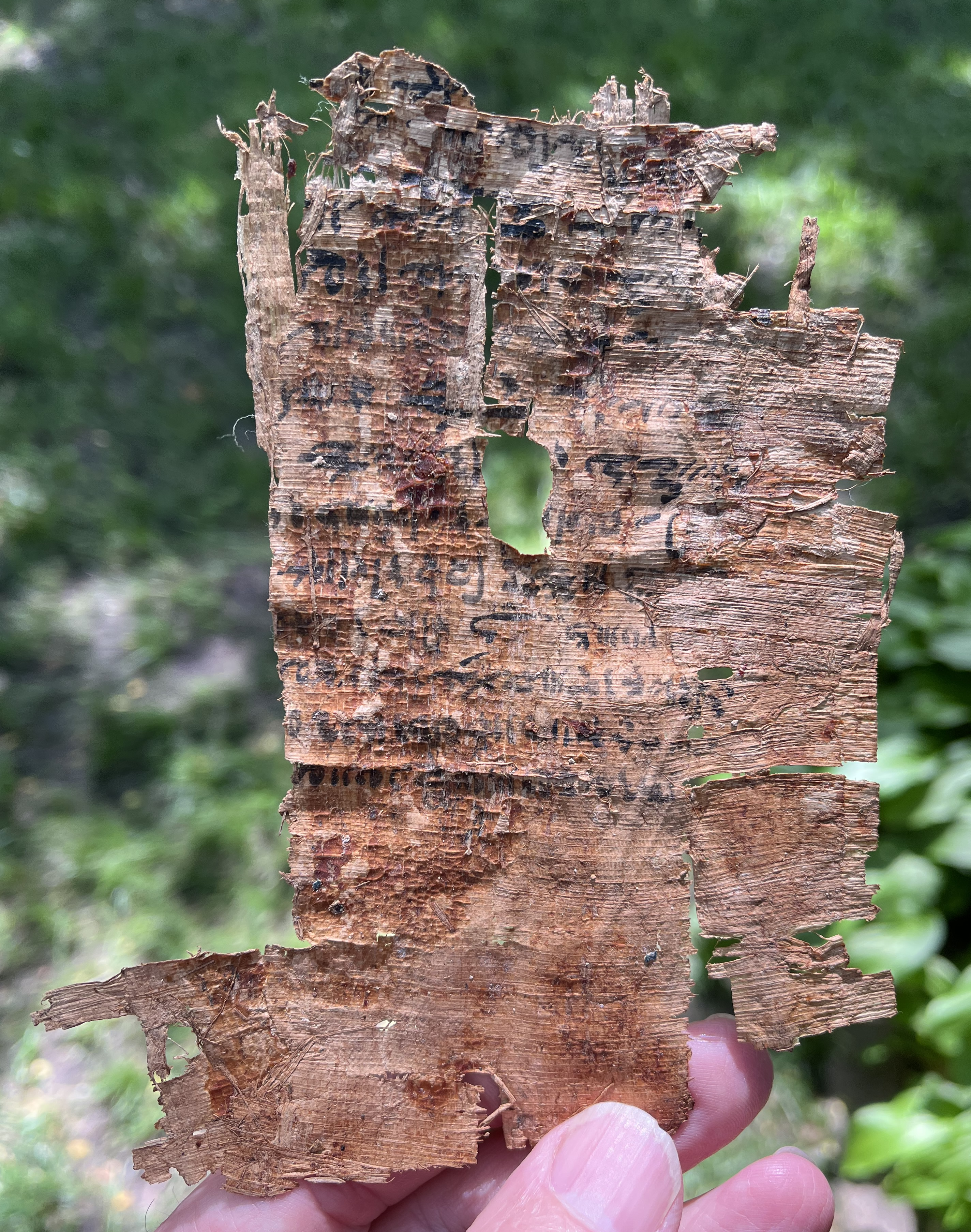 |
Demotic script on Egyptian papyrus from 400 BC-100 AD |
 |
Papyrus with written text from the same time period as when Malachi, Matthew and John wrote their books, 450 BC - 100 AD. |
 |
Near Eastern bronze arrow points from 1200-800 BC or the time of the book of Judges through King David until time of King Ahab and Jezebel. |
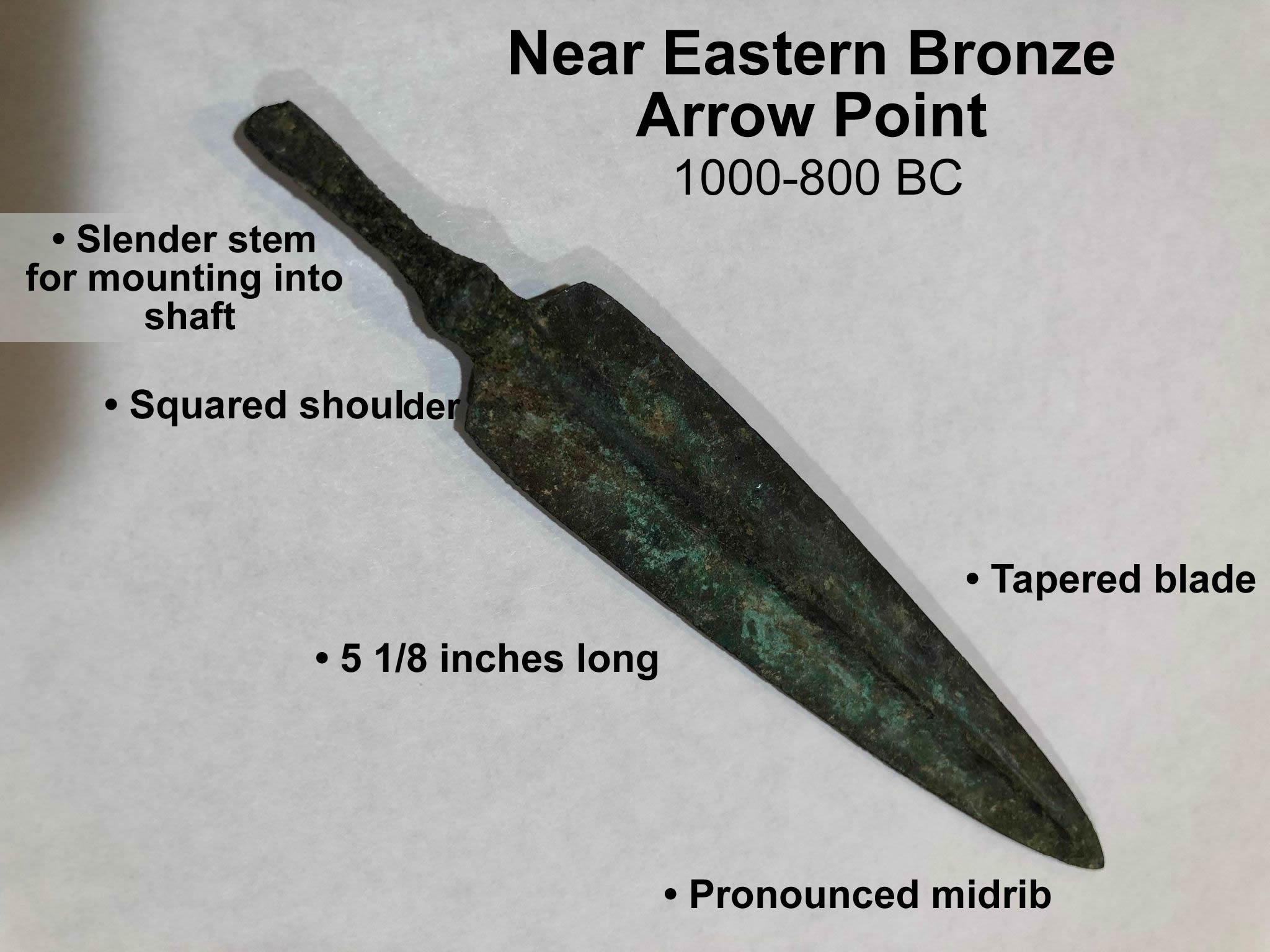 |
Details of a Near Eastern bronze arrow point from 1000-800 BC or the time of King David and Solomon in the Middle East. |
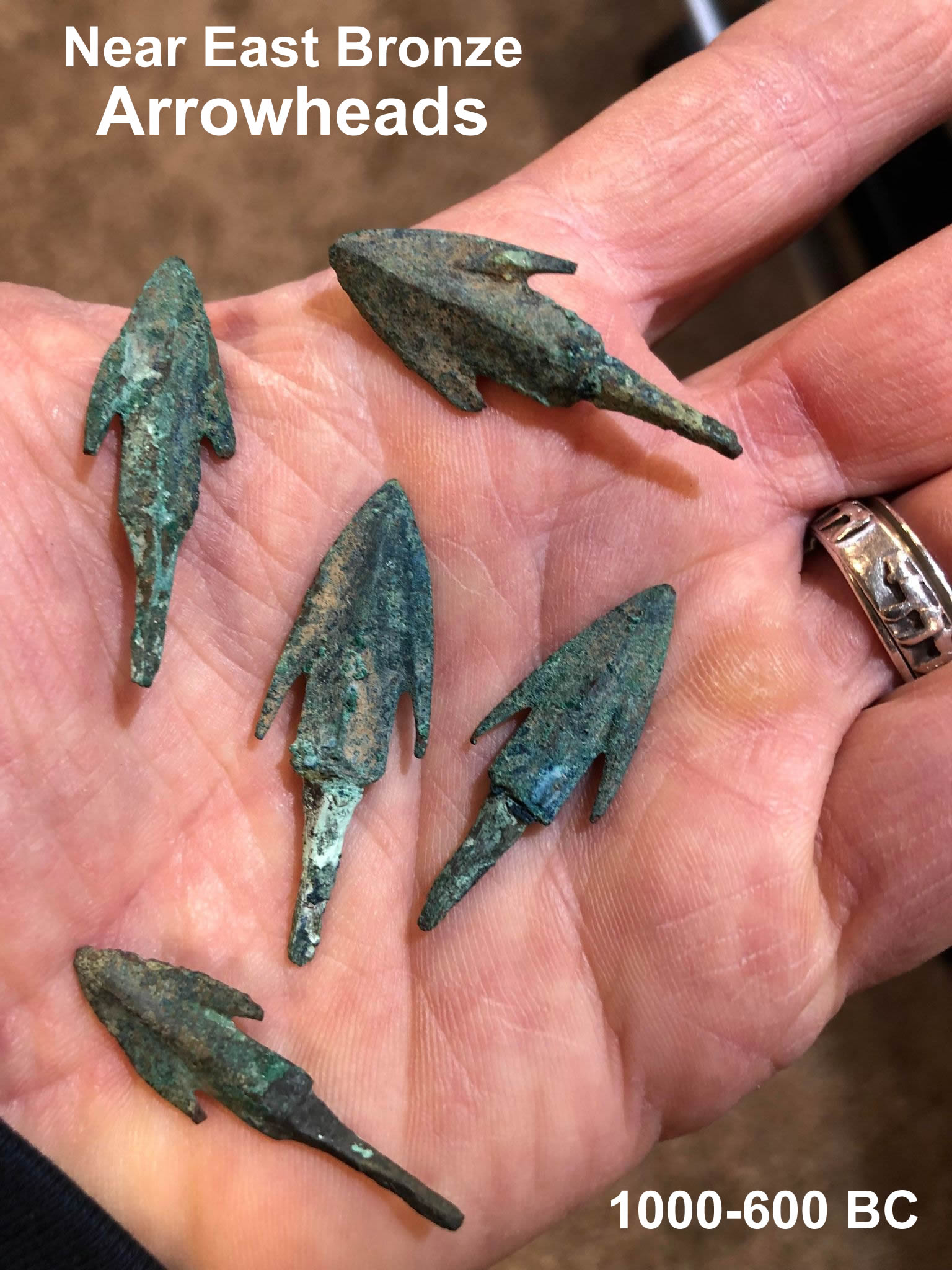 |
Middle East bronze arrowhead from the time of King David to King Josiah and Isaiah and Jeremiah (1000-600 BC). |
 |
1500-1000 BC bronze sword from western Iran east of the Tigris River in Loretan Province in Zagros Mountains. A Luristan Sword. |
 |
Left to Right:
1400-1000 BC Luristan bronze sword;
2100-1570 BC Anatolia bronze dagger;
1000-600 BC Middle East bronze dagger;
1000-700 BC Luristan bronze spear point. |
 |
1200-500 BC Iron Age jar with handle

|
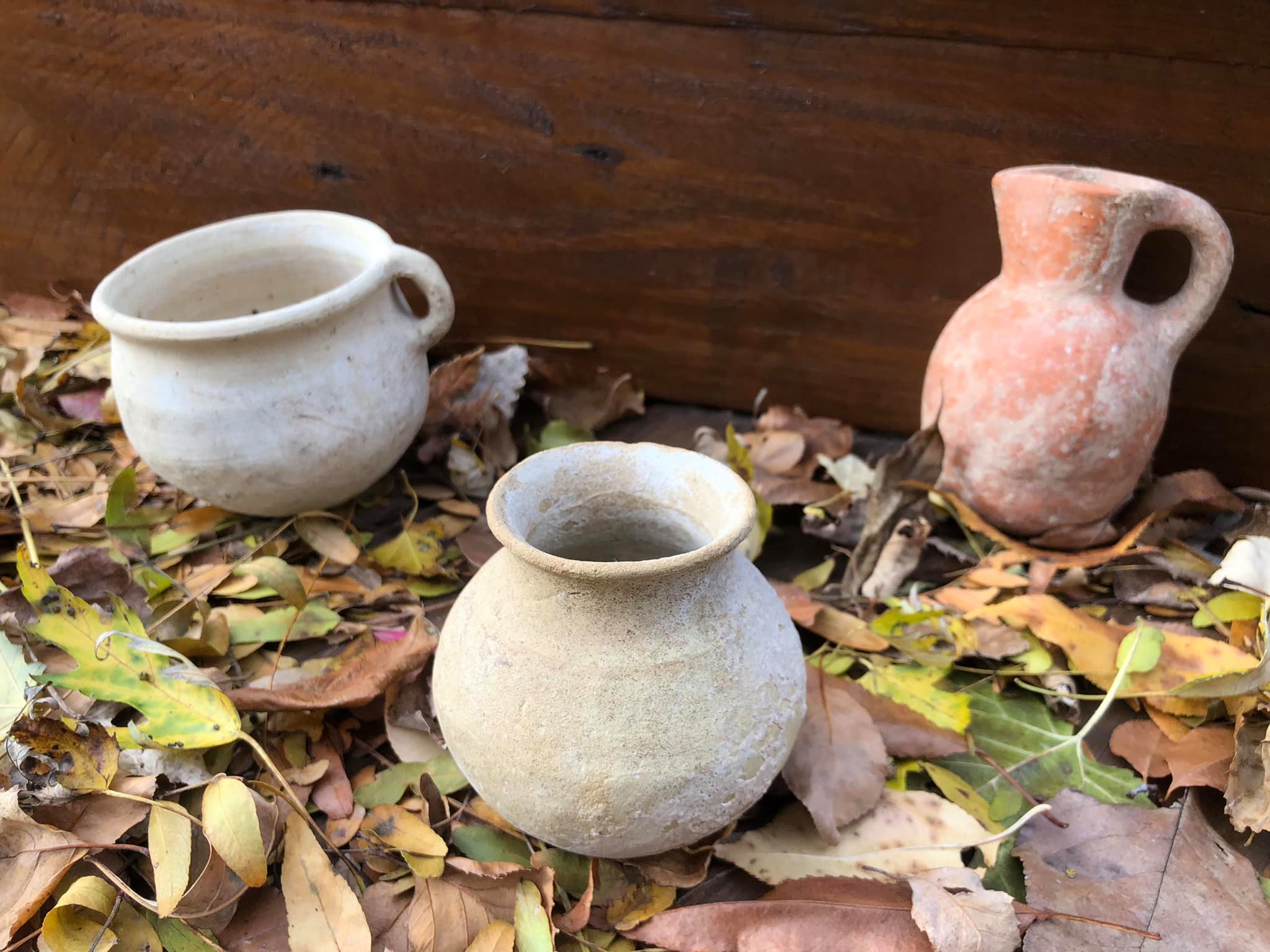 |
Right to left:
1200-500 BC Iron Age jar with handle from Israel;
1200-500 BC pottery vessel from Israel;
2000-1500 BC ceramic juglet |
 |
1200-500 BC pottery vessel from Israel |
 |
200-25 BC, a Hellenistic olpe, or said another way, a Greek jug for wine during the Hasmonean Period |
 |
2000-1500 BC ceramic juglet

|
 |
These are bronze Roman coins from 200 AD. This Roman bronze coin did not have value like the silver in a silver coin has value because it is silver. These 200 AD coins only had value in the Roman Empire because it was stamped “SC”, not because the bronze had any value. The “SC” means Senatus Consulto, which means “with permission of the senate”. The Roman Senate needed to circulate more money to save their economy so they printed worthless money on bronze coins and stamped it as with “SC” which basically meant, “this money has value because the Senate decreed it has value”. This did not work because around 200 AD the Roman economy took a drastic turn from which it was never able to recover. The problem was compounded by the Antonine plague brought back to Rome from the eastern provinces by Roman soldiers. |
 |
Minted 27-14 BC for Caesar Augustus. This bronze coin says AUGUSTUS and is encircled in a wreath on the back. Caesar Augustus was emperor when Jesus was born. |
 |
Image of Caesar Augustus on a Roman coin minted during his reign between the years 27-14 BC. |
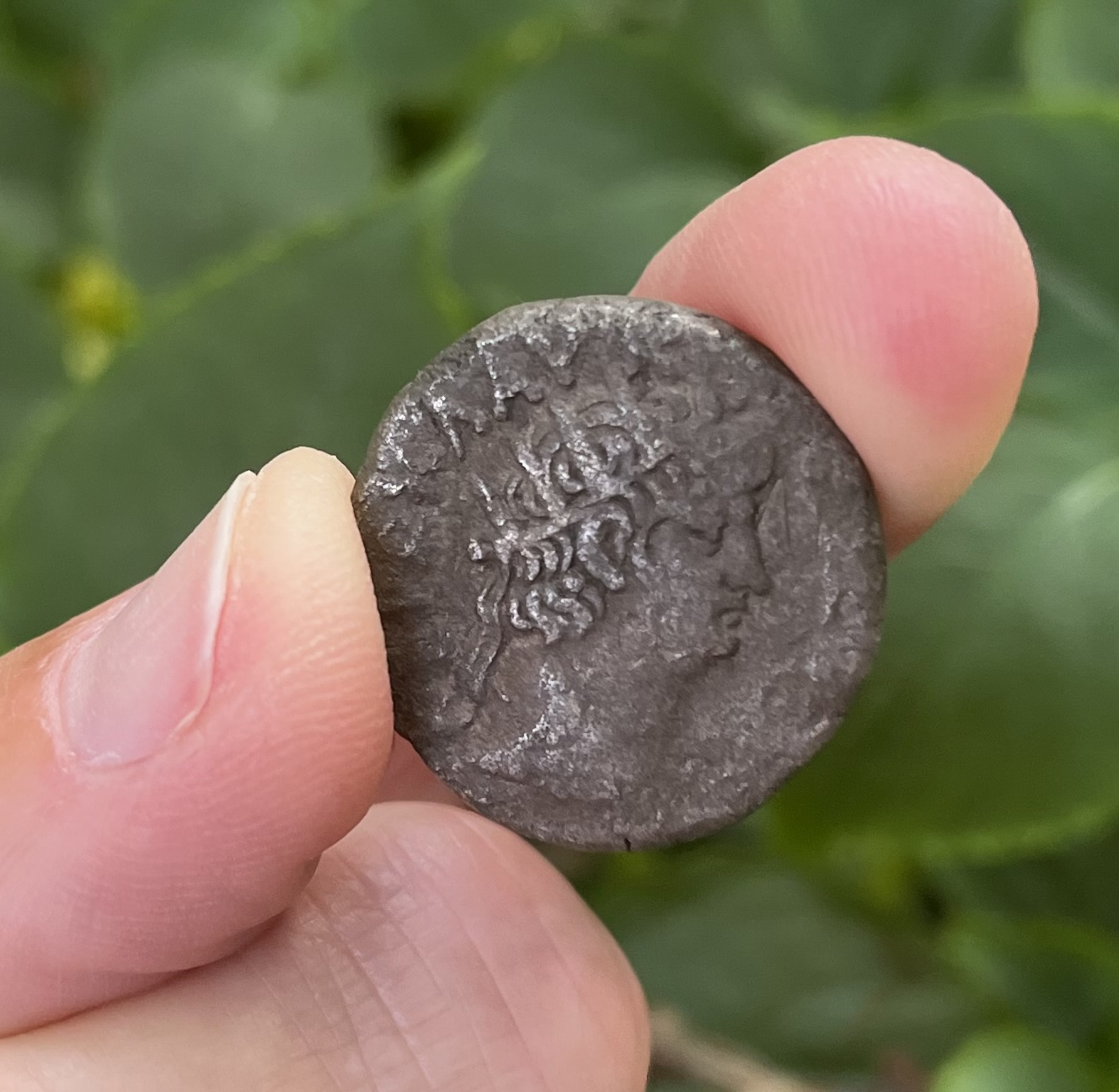 |
The front of this coin has an image of Nero. This coin was minted in 65/66 AD during Nero’s reign (54-68 AD). He is shown wearing a radiant head piece to signify his deity. Across the top it says NERO CAESAR AVG IMP which is his name and titles. Nero took the title CAESAR. The AVG is the abbreviation for Augustus. IMP is the abbreviation for the title Imperator which indicates Nero had martial powers conferred on him for having been “a victorious general”. Clearly seen on this coin is the …ESAR AV…. By the time this coin was minted Nero had started killing Christians in Rome. Peter had been executed by Nero in 64 AD just 12-18 months before this coin was minted. Paul was about 12-18 months away from his arrest at Troas in 67 AD and his second imprisonment. It was during this second imprisonment Paul would write to Timothy the book we call Second Timothy a few months before he was executed by Nero in the fall of 67 AD or the spring of 68 AD. |
 |
This coin was minted in 77/78 AD with the image of Vespasian (reigned 69-79 AD). This coin is lettered with IMP CAES VESPASIAN AVG COS VIII. Only the …MP CAES VESPASIAN A… can be made out on this coin. The IMP is the title Imperator. CAES is Caesar. VESPASIAN is the name of the former Roman general who is now ruling the empire. AVG is abbreviation for the title of Augustus. The COS cannot be seen, but it stands for “office of consul”. It is followed by VIII which indicates this is Vespasian’s 8th year to hold the office of consul which makes the year this coin was minted 77/78 AD. Vespasian was the general who began the Jewish wars in 66 AD and took the Jewish general Josephus captive when Josephus surrendered in 67 AD. Josephus claims to have prophesied to Vespasian that Vespasian would be the next emperor. Nero was still ruling at that time and the Apostle Paul was Nero’s prisoner when Josephus surrendered to Vespasian. Vespasian did become the emperor in 69 AD leaving his son General Titus to finish the destruction of Jerusalem and end the Roman war with the Jews. This coin was minted 7 years after the fall of Jerusalem while the Apostle John was still teaching in Asia Minor and about 8 years before Vespasian’s son (and, Titus’ brother) Domitian exiled John to the isle of Patmos where John would write the book of Revelation. |
 |
A coin of Constantine the Great from 306-337 AD with his image on the front of the coin. The lettering says CONSTANTINVS MAX AVG. First, his name, Constantine. MAX is abbreviation for maximus which means he is the greatest and highest ranking individual in the empire. AVG is abbreviation for augustus which identifies him as the emperor. |


|
This is a coin minted by Herod the Great. The first photo is the front (obverse) side with an anchor. The anchor was a symbol of the Seleucid Empire which was overthrown by the Jewish Maccabean revolt. The Jewish Hasmonean dynasty (140-37 BC) that resulted from the Maccabean Revolt then used this anchor as their symbol on the coins they minted. Herod, who began to rule in 40 BC, continued to use the anchor on his coins. This copper coin is called a prutah. A prutah had a very low value that was equal to two lepta (or, “Widow's Mites”), which was the smallest denomination minted.
This small copper coin called a prutah is worth two lepton (or, two widow's mites)
On the reverse side in the second photo the coin shows two connect cornucopia, the symbol of plenty and an abundant supply of good things. Extending up into the middle of the cornucopia is a staff made up of a pair of snakes intertwined forming a circle at the top of the staff where their heads meet. This staff, called a Caduceus or kerykeion, is the symbol of Hermes/Mercury in Greek/Roman mythology. It was the symbol used to identify merchants, messengers, and also, thieves. This staff would be carried by messengers or heralds, but also carried by referees at athletic contests and at the Greek Olympic Games which Herod the Great financed and presided over in 12 BC. |
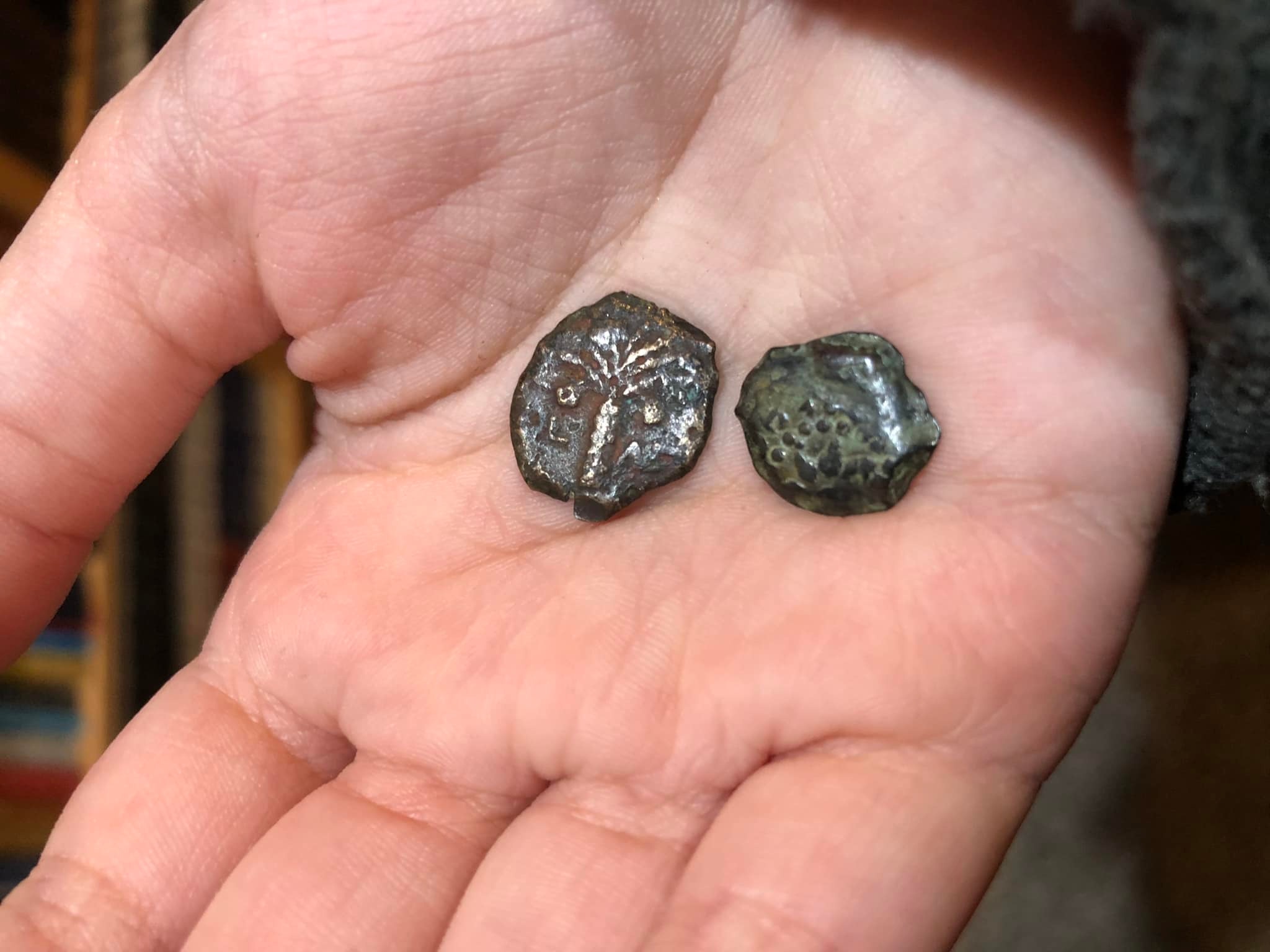 |
These are “widows mites” or lepton, small bronze coins worth about 6 minutes of manual labor each, were minted 9-12 AD with images of a palm tree and a barely ear of grain.
The smallest bronze coins from the time of Jesus were called a lepton (or, mite). One was equal to the workers earnings for about six minutes of work and thus the least valuable coin in Israel in the first century. Two lepta equaled the value of one prutah. Lepta were first minted by Alexander Jannaeus around 80-76 BC with the image of an anchor (obverse) and a wheel with 8 spokes/8 pointed star (reverse). These coins were still in circulation in 30 AD along with the lepton minted by Marcus Ambivulus between 9-12 AD with images of a palm tree and a barely ear of grain. Jesus talks about a widow who put two of these bronze lepta in the offering at the Temple in Luke 21:1-4.
“As Jesus looked up, he saw the rich putting their gifts into the temple treasury. He also saw a poor widow put in two very small copper coins. ‘Truly I tell you,’ he said, ‘this poor widow has put in more than all the others. All these people gave their gifts out of their wealth; but she out of her poverty put in all she had to live on.’ ” – Luke 21:1-4 |


|
The front and back of the bronze “Widows Mite” with a palm tree (which produced dates and can reach 100 feet tall) on one side and a barely ear of grain on the other.
These were minted by Marcus Ambivulus in 9-12 AD while Jesus was a young teenager. Marcus Ambivulus was the Roman Prefect assigned to the Roman province of Judea which included Judea and Samaria. Marcus Ambivulus was the second Roman Prefect and, after two others, he would be followed by Pontius Pilate (26-36 AD). |
 |
These are examples of the small brone lepta coin first minted by Alexander Jannaeus around 80-76 BC with the image of an anchor (obverse) and a wheel with 8 spokes/8 pointed star (reverse). These coins were still in circulation in 30 AD. Portions of the design on the front and back (obverse and reverse) sides of 20-30 widows mites can be recognized in this photo showing pieces of the coin in an ancient bronze bowl from the time of Hezekiah and Isaiah (700 BC). Notice the pieces with the 8 spoked wheel or 8 pointed star and others with the anchor. |
 |
Three iron Roman nails from the first century. |
 |
Samples of authentic oil lamps produced and used from 2200 BC-900 AD. |
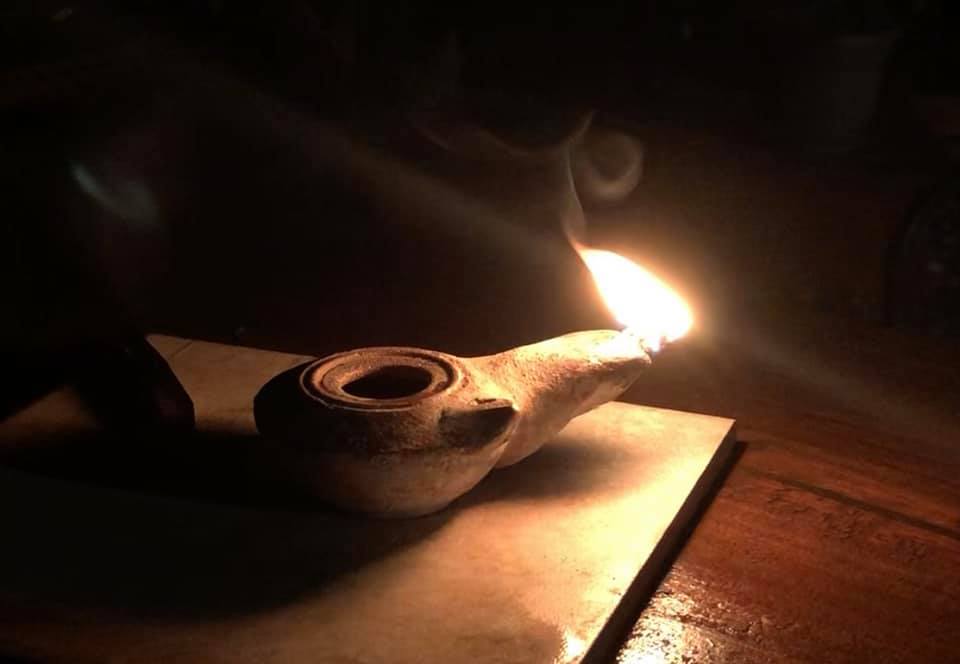 |
An oil lamp from 100 BC-100 AD filled with olive oil and using a piece of cotton rope fiber for a wick burns to give light in 2021 on Galyn’s deck in Iowa, USA. |
 |
The earliest oil lamps were shaped like a flat saucer with the rim pinched in a single location to hold the wick. Before this design it is likely the wick floated in a shallow saucer of oil or hung against the edge. This saucer shaped lamp with the rim pinched in a single location would have been in use during the life of Shem and Abraham’s father, Terah (2200 BC). |
 |
During the Canaanite period 2200-2000 an oil lamp with four pinches developed. Abraham and Melchizedek would have been familiar with this design (2200-2000 BC). |
 |
Around the time of the Exodus the rim of the oil lamp and the pinch that held the wick gradually became more defined. This lamp design (1500-1200 BC) was in use in the land of Canaan during Moses life. Joshua would have used this design as would the people in the book of Judges. |
 |
The trend of a defined rim, deeper oil bowl and an emphasized pinch for the wik continued through the Old Testament times. These saucer lamps were not carried, but were set on shelves or in niches in walls. The kings of Judah and the prophets such as Isaiah, Jeremiah and others would recognize this lamp (930-330 BC). |
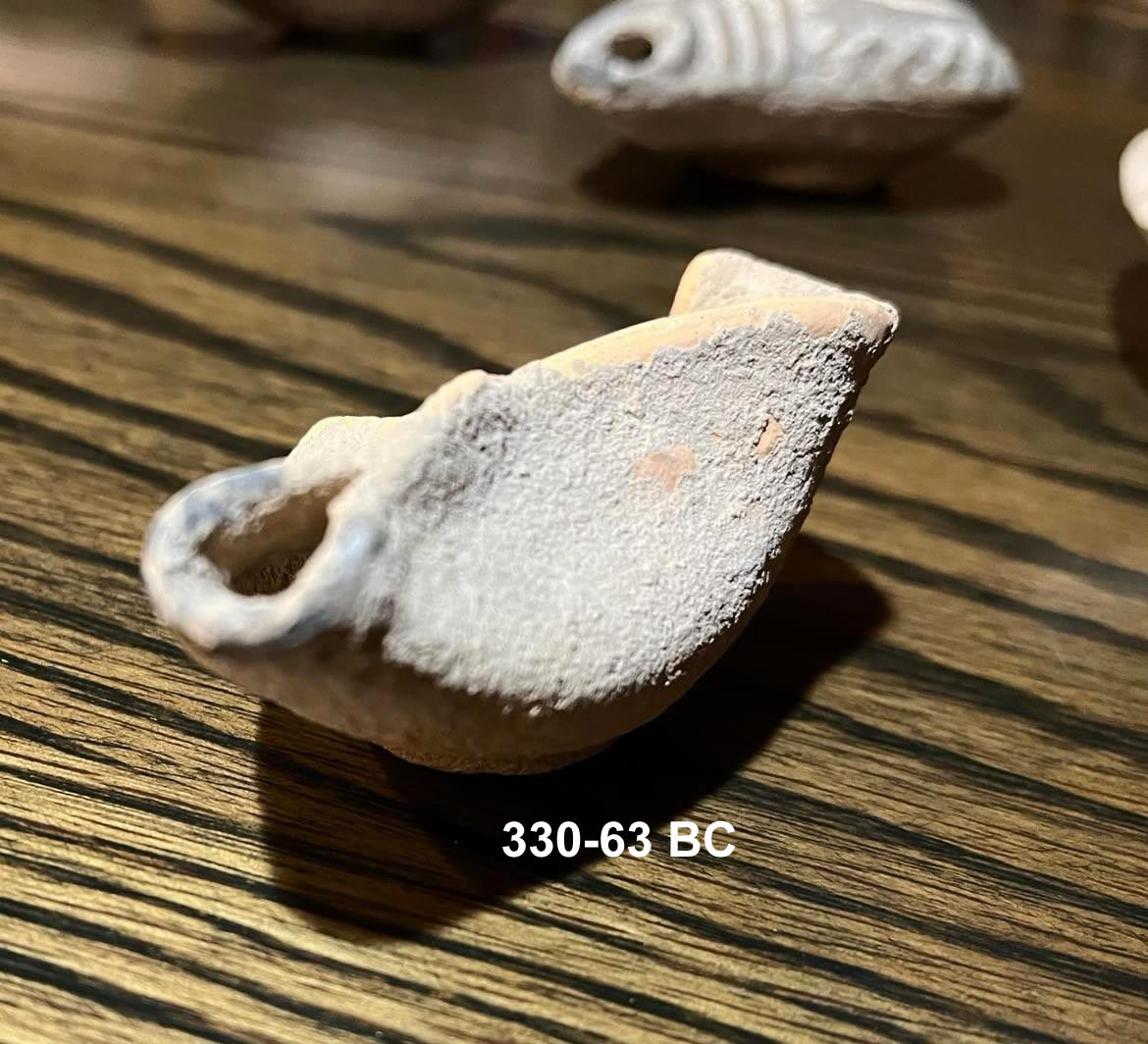 |
By the time of the Greeks arrived into the land of Israel the pinch in the saucer lamp had made contact and closed the top leaving an opening for the wick. The oil lamp designed as a saucer disappeared and gave way for these smaller oil lamps. Also, a flat base was added to stabilize the oil lamp when it was set on a stand or a shelf. |
 |
With the rise of the Greek Empire in the east Israel began importing the popular round Hellenistic lamps that were covered and glazed with a black/brown to reddish slip. This lamp was imported to Israel sometime between the Old and New Testament (300-50 BC). |
 |
This typical Roman lamp swept through the Roman Empire (100 BC-200 AD). These oil lamps were round and set higher with a larger bowl to hold oil. The nozzle for the wick was short. The center was closed with a circular center that was molded with a scene from Roman life. The bowls were made with a mold by craftsmen in workshops. In the closed center circle would be a small hole to fill the lamp with oil. These lamps, along with other designs, were used in the Gospels and throughout the New Testament period into the time of the early church. Paul would have used lamps designed like this in Israel and in his travels through the Roman Empire. |
 |
The molded center scene on this lamp is husband and wife embracing. The rim encircles this Roman lamp with a woven leaf pattern. Also, notice the handle has been added and these lamps were carried around similar to Jesus parable in Matthew 25:
“At that time the kingdom of heaven will be like ten virgins who took their lamps and went out to meet the bridegroom. Five of them were foolish and five were wise. The foolish ones took their lamps but did not take any oil with them. The wise ones, however, took oil in jars along with their lamps.” |
 |
This is an example of a Herodian oil lamp from the time of Jesus and a Hellenistic juglet that was used to carry oil or wine. The juglet could be used to carry extra oil for the lamp.
An oil lamp and a jug of extra oil as in Matthew 25. |
 |
The Herodian period lamp of Israel (63 BC-200 AD) was a simple design with a plain circular bowl shaped on a pottery wheel. It may have been for religious reasons the design was so bare, since the Herodian period clearly had the time, resources and skill to produce something more elegant. A nozzle was attached to the bowl by hand and a blade was used to scrape the clay smooth (see image) where the nozzle connected to the bowl, thus this style is called the “scraped lamp”. The lamp pictured here has the common design of this style with a round shoulder and a large fill hole encircled with a ledge to help the oil drain into the bowl. The nozzles on the Herodian lamps broaden out to open end that was arched or curved where the wick was set. |
 |
With the Roman Wars of 66-70 AD and the destruction of Jerusalem in 70 AD the shops and production of the artists and craftsmen was stopped. People fled and the urban centers collapsed. A distinct new oil lamp design developed from the agricultural population. The lamp design that emerged is called the Darom oil lamp from the Hebrew word darom that means “south” and identifies a scattered people moving south into the rural agricultural life. The designs in these lams focuses on floral, vines, grains common to Israel or common farming equipment and house hold items. The design includes a handle and a clear circular base to set on. |
 |
Oil lamp from 200-600 AD |
 |
When viewed from the top the Byzantine oil lamp fits into the shape of an elongated triangle with the corners of the triangles bae rounded. It is interesting that the Christian Byzantines overwhelming used the Jewish menorah to decorate these lamps. One theory for this tendency is to consider that these Christians were Jews. Some researches identify the menorah image as a palm branch. Of course, since the menorah is a lamp it is logical to put its image on an oil lamp. Crosses and floral designs, among others patters also appear, but the menorah is a dominant feature on Byzantine oil lamps between the years 400-600 AD. |
 |
Oil lamp from 600-900 AD |
 |
Golden Menorah with seven oil lamps |
 |
Two lit and burning oil lamps from the days of the New Testament |
 |
Galyn lights an ancient oil lamp for the first time in 2,000 years while three of his grandchildren watch. |
| |
|
